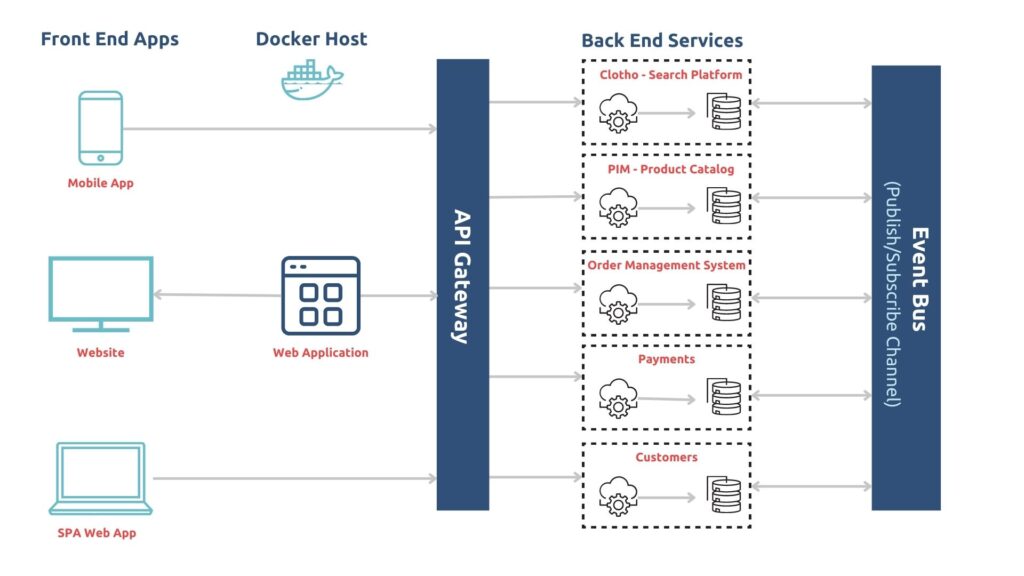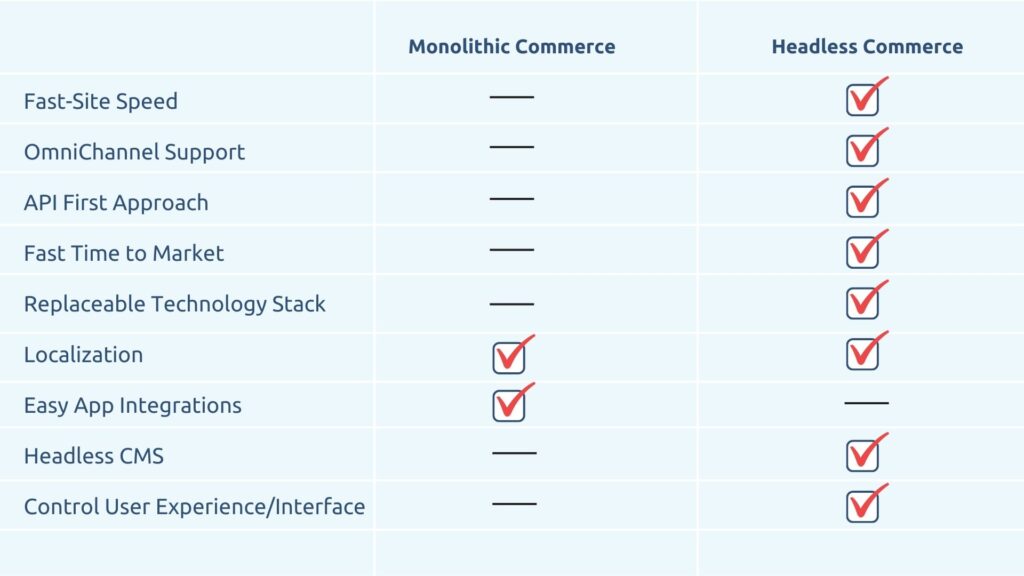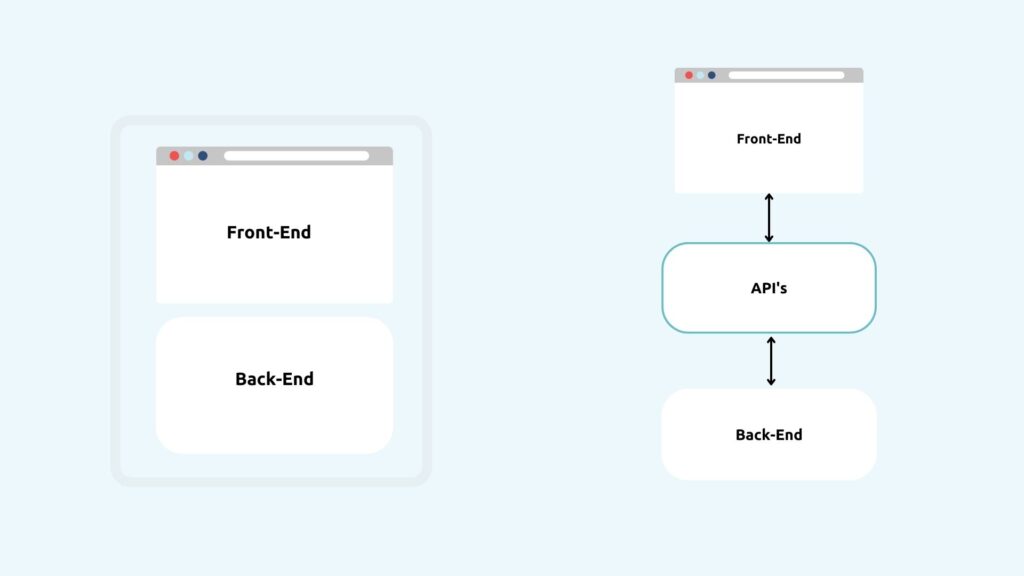In the world of ecommerce, the buyer’s journey is no longer straightforward. The internet provides potential customers with multiple platforms for purchasing products. They include social platforms, mobile devices, online marketplaces, augmented reality, as well as smart devices integrated with smart homes and vehicles. Headless ecommerce platforms provide the foundation to interlink platforms for a store and creates a seamless and consistent shopping experience.
Headless commerce is a term that retail ecommerce businesses should familiarize themselves with as it continues to gain popularity. TechCrunch, a startup and technology news reporter, stated that in May 2022, Storyblok, a content management system (CMS) provider, raised over $47 million to create a headless CMS for their non-technical customers.
But what really is headless commerce? And is headless architecture really worth the hype? This guide gives a quick overview of headless ecommerce platforms, the differences between monolithic and headless architecture, and businesses that found success in their headless approach.
A headless ecommerce platform is defined as a front-end decoupled from the functionalities happening at the back-end such as web security, sales management, product management, and business logic.
Each touchpoint acts as a separate “head” of the platform. Then, the commerce functionality is implemented across all heads. Therefore, each head receives its own data so that retailers can present it in an app-like manner on any device.
Why do Marketers and Developers Love the Headless Approach?
Developers find the headless ecommerce flexible, faster, and easier to implement. The ease and speed are due to the back-end being separate from the presentation layer of the platform. Changes to the back-end happen without impacting the layout design on the front-end.
After transitioning to a headless approach, ecommerce platforms allow marketers to have the ability to fully customize each touchpoint. The marketing team has the capacity to create unforgettable and highly customized shopping experiences for the customers.
What is Headless Commerce Architecture?
In headless architecture, all the business logic, sales, and product management are contained in multiple APIs. Each API receives support from the back-end. The front end attaches itself to any of the APIs according to the needs of the customer to seamlessly deliver the results.
For example, an ecommerce business can utilize social media, a mobile app, and a website. Instead of implementing the order-placement event on each touchpoint, it is created in an API that attaches itself to whichever touchpoint calls it.
3 Types of Headless Architecture
Headless architecture has developed into the following 3 types:
- API-driven ecommerce platform headless architecture is useful for businesses that have a static back-end and do not make regular changes to their front-ends.
- Utilizing the APIs, they can update changes to the front-end without hassle.
Read our detailed blog “What is API-Driven Commerce and Its Benefits for your Business” to learn more.
2. Based on API-driven CMS
- API-driven CMS headless architecture is beneficial for businesses looking to develop a content rich platform.
- It is easy to integrate with an existing content management system.
- APIs provide the connection between the front-end and back.
3. Based on Microservices
- Microservice-based headless architecture helps businesses that want to create multiple user journeys and regularly update their back-end services.
- Microservices allow businesses to create, update, or edit the front and back end whenever they like.
4 Key Features of Headless Commerce Architecture:
Following are the 4 key features of the headless commerce architecture:
1. Headless Services (Backend)
Headless services in the backend consist of the core ecommerce functionalities: order, promotions, cart, catalog, product, customer, and all the other business logic functionalities.
Implementation
Any technology such as NodeJs, Ruby, REST+JSON API, JAVA, and other similar technology can be used to develop the backend.
2. Service APIs
APIs stand for Application Programming Interface. APIs serve as a means of communication between the front and back end. These service APIs remove any dependencies between the functionality and the UI.
Implementation
APIs take requests from the front end and deliver them to the back end. Once translated and processed, APIs return back to the user interface.
Any server-side technology such as NodeJs, Ruby, and REST+JSON API can be used for implementation.
3. Channel head (frontend)
The channel head is the front-end section where you can build the storefront. The customer interacts with and navigates the platform through the front end. Businesses use the channel head to create easy purchasing journeys for their customers.
Implementation
The front-end is hosted on the cloud, the hosting provider can be any organization such as Amazon Web Services, Google Cloud, or Microsoft Azure. React, Vue, Flutter, and React Native are common technologies used to develop the front end.
4. Data sources
Multiple data sources integrate with a headless platform. They are business systems that handle corporate data. If there is no corporate data involved, then databases directly retrieve the data.
High-Level Diagram of Headless Ecommerce Architecture

Headless vs Monolithic Ecommerce Platforms
Monolithic ecommerce architecture hosts the frontend and backend under one virtual roof. Whereas, headless architecture keeps each working part separate to prove a flexible solution. Monolithic platforms are easy to implement, however they are harder to upgrade. Meanwhile, headless commerce can take longer to implement due to the customizations available. However, headless platforms can scale and upgrade easily as businesses grow and evolve. Monolithic platforms focus on improving the customer experience without catering to the development side. Headless commerce platforms aim to provide solutions for both aspects. The following table represents the major differences between the two:
 A comparison checklist between monolithic commerce and headless commerce.
A comparison checklist between monolithic commerce and headless commerce.
| Monolithic Ecommerce Platforms | Headless Ecommerce Platforms |
– Easy to build. Low cost to build, higher cost to maintain.
– Difficult to modify or upgrade.
– Impossible to incorporate different services.
– Unable to quickly adapt to provide the best customer experiences.
– Can only access a limited set of technology. | – Slightly more challenging to build from scratch.
– Higher costs initially to build the platform, lower cost to maintain.
– Different services are easily incorporated to maximize the usability.
– Upgrades are easily made to improve customer experiences.
– Developers have unlimited options for available technologies. |
A few differences between the monolithic and headless ecommerce platforms. The difference in the architecture of monolithic and headless ecommerce platforms.
The difference in the architecture of monolithic and headless ecommerce platforms.
The following are key benefits of implementing a headless platform:
1. Agile Development
A headless platform can support multiple technologies. Each touchpoint is developed, tested, and launched independently. Individual development also increases the flexibility of the platform because there are multiple options to upgrade the platform to meet any requirements.
2. Team Empowerment
Teams have the power to utilize any technology available in the market to create the best customer experiences. Due to the independent functionalities, teams can make their own decisions without waiting for approval from other teams. Therefore, the division of tasks in each team is straightforward.
3. Regular Customizations
Teams can customize the front and backends regularly as needed. If the marketing team wants to implement a new experience for the customers on the front end, they can do so without worrying about the backend changes. Similarly, if a team needs to update functionality on the back end, the front end is not disturbed In the process.
4. Become a Truly Unified Platform
Headless commerce allows organizations to provide a seamless and unified experience across all channels. The data of catalogs, prices, and discounts update and sync in real-time across every touchpoint.
Learn more about unified platforms in the blog “What is Unified Commerce? And Why is it a Necessity in 2022”.
5. Save Costs
Businesses see long-term savings after implementing the basic functionalities. Customer experience-led strategies can help attract organic traffic to the website instead of relying solely on advertising.
6. Create Mobile-First Experiences
Mobile devices are used to scroll through social media and expose audiences to a variety of ecommerce advertising. Ecommerce businesses can leverage mobile platforms to place ads in front of their potential customers.
It is necessary for ecommerce businesses to utilize mobile-first applications that allow customers to browse and make purchases Organizations can use headless architecture to easily create their own mobile-first platforms.
7. Improve Site Speed
Headless commerce improves site speed because developers maintain full control of the page structure and the content. Implementing open source solutions and using minimal plugins reduces loading time.
- Nike
Nike implemented the mobile-first approach using headless commerce architecture. Their goal was to capture the market of customers that use their mobile phones more than desktop websites. Therefore, they improved elements such as their call-to-action buttons, images, and visuals to accomplish this task.
Nike started to gain more customers quicker than its major competitor, Adidas. According to a report generated by Statista, Nike’s direct-to-consumer brand NIKE Direct generated approximately $18.7 billion in revenue in the 2021- 2022 fiscal year.
- Target
Target has two major competitors; Amazon and Walmart. Their customers often switch from one brand to another. After careful analysis, Target realized that most customers would begin their product research on one device and eventually switch to another for purchasing.
Quickly, they implemented a headless approach and unified their customers’ journey across all platforms. It is concluded in a blog by Convert Cart, a Software as a Service provider, that Target’s conversion rate increased when customers found it easier to finish their purchasing journey.
- United Airlines
Utilizing the services of Sitecore, United Airlines implemented headless architecture to create an effortless experience for their customers. The platform now provides its customers an agile and dynamic platform that serves the customers with the personalized content they need.
Conclusion
According to Forbes, headless commerce received $1.6 billion in funding. This is because ecommerce organizations are realizing the benefits and potential of headless architecture. Technology is constantly changing. Headless commerce platforms are the perfect solution to create unique experiences for customers throughout their buying journey.
It is important to understand headless commerce before making the decision to switch to a headless ecommerce platform. Analyze the pros and cons to understand if a headless approach is a right fit for your business.
Ready to implement the headless architecture? Explore the various options offered by UpStart Commerce today.
